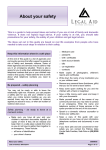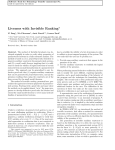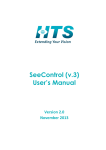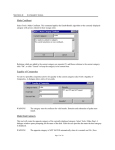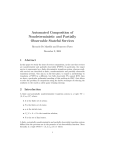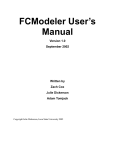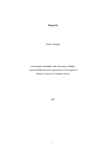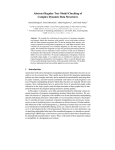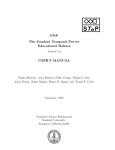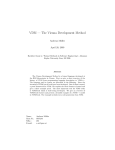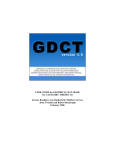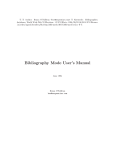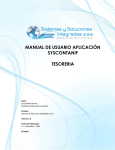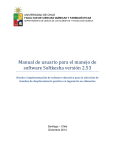Download tloc - Computer Science
Transcript
Liveness with Invisible Ranking
Yi Fang , Nir Piterman , Amir Pnueli , and Lenore Zuck
New York
University, New York, yifang,zuck @cs.nyu.edu
Weizmann Institute of Science, Rehovot, Israel
nirp,amir @wisdom.weizmann.ac.il
Abstract. The method of Invisible Invariants was developed originally in order
to verify safety properties of parameterized systems fully automatically. Roughly
speaking, the method is based on a small model property that implies it is sufficient to prove some properties on small instantiations of the system, and on a
heuristic that generates candidate invariants. Liveness properties usually require
well founded ranking, and do not fall within the scope of the small model theorem. In this paper we develop novel proof rules for liveness properties, all of
whose proof obligations are of the correct form to be handled by the small model
theorem. We then develop abstractions and generalization techniques that allow
for fully automatic verification of liveness properties of parameterized systems.
We demonstrate the application of the method on several examples.
1 Introduction
Uniform verification of parameterized systems is one of the most challenging problems
in verification today. Given a parameterized system and a
property , uniform verification attempts to verify "! #$ for every &%' . One
of the most powerful approaches to verification which is not restricted to finite-state
systems is deductive verification. This approach is based on a set of proof rules in
which the user has to establish the validity of a list of premises in order to validate a
given property of the system. The two tasks that the user has to perform are:
1. Identify some auxiliary constructs which appear in the premises of the rule.
2. Establish the logical validity of the premises, using the auxiliary constructs identified in step 1.
When performing manual deductive verification, the first task is usually the more difficult, requiring ingenuity, expertise, and a good understanding of the behavior of the
program and the techniques for formalizing these insights. The second task is often
performed using theorem provers such as PVS [21] or ST eP [4]. The difficulty in the
execution of these two steps is the main reason why deductive verification is not used
more extensively.
A representative case is the verification of invariance properties using the invariance
rule of [17]. In order to prove that assertion ( is an invariant of program , the rule requires coming up with an auxiliary assertion ) which is inductive (i.e. is implied by the
*
This research was supported in part by the Minerva Center for Verification of Reactive Systems, the European Community IST project “Advance”, the Israel Science Foundation (grant
no. 106/02-1), and NSF grant CCR-0205571.
initial condition and is preserved under every computation step) and which strengthens
(implies) ( .
In [19, 2] we introduced the method of invisible invariants, which proposes a method
for automatic generation of the auxiliary assertion ) for parameterized systems, as well
as an efficient algorithm for checking the validity of the premises of the invariance
rule. In this paper we generalize the method of invisible invariants to deal with liveness
properties.
The method of invisible invariants is based on two main ideas:
It is often
the case that the auxiliary
assertion
for a parameterized system has the form
) (or, more generally,
#
.) We construct an instance of the parameterized system taking a fixed value for the parameter . For the finite-state
system , we compute the set of reachable states using a symbolic model
checker. Let ( be the projection of on process index , obtained by discarding
references to all variables which are local to all processes other than . We take to be the generalization of ( obtained by replacing each reference to a local variable
by a reference to . The obtained is our candidate for the body of the
inductive assertion ) . We refer to this part of the process as projection and
generalization.
Having obtained a candidate for the inductive assertion ) , we still have to check
the validity of the three premises of the invariance rule. Under the assumption that our
assertional language is restricted to the predicates of equality and inequality between
bounded range integer variables (which is adequate for many of the parameterized systems
we considered), and the fact that our candidate inductive assertions have the form
, we managed to prove a small model theorem. According to this theorem, there
exists a (small) bound such that the premises of the invariance rule are valid for every iff they are valid for all . This enables us to use BDD techniques in order
to check the validity of the premises. This theorem is based on the fact that, under the
!
above
assumptions, all three premises can be written in the form , where
is a quantifier-free assertion which may refer only to the global variables and
the local variables of and .
Being able to validate the premises on has the additional important advantage
that the user does not have to see the automatically generated auxiliary assertion ) .
This assertion is generated as part of the procedure and is immediately used in order to
validate the three premises of the rule. This is advantageous because, being generated
by symbolic BDD techniques, its representation is often extremely unreadable and nonintuitive, and will usually not contribute to a better understanding of the program or its
proof. Because the user never gets to see the auxiliary invariant, we refer to this method
as the method of invisible invariants.
In this paper, we extend the method of invisible invariants to apply to proofs of the
second most important class of properties which the class of response properties.
$#&These
%
"
( are liveness properties
which
can
be
specified
by
the
temporal
formula
%
(also written as #('
( and guarantees that any -state is eventually followed by
a ( -state. To do so, we consider a certain variant of rule WELL [16] which establishes
the validity of response properties under the assumption of justice (weak fairness). As
is well known to users of this and similar rules, such a proof requires the generation
2
of two kinds of auxiliary constructs: “helpful” assertions which characterize the states
at which a certain transition is helpful in promoting progress towards the goal (( ), and
ranking functions which measure the progress towards the goal.
In order to make the project-and-generalize technique applicable to the automatic
generation of the ranking functions, we developed a special variant of rule WELL, to
which we refer as rule D IST R ANK. In this version of the rule, we associate
#
with each
, mapping
potentially helpful transition an individual
ranking
function
states to integers in a small range , where is a fixed small constant, independent
of the parameter . The global ranking function can be obtained by forming the multiset . In most of the examples we considered, it was sufficient to take the range of
the individual functions to be , which enable us to view each as an assertion,
and generate it automatically using the project-and-generalize techniques.
The paper is organized as follows: In Section 2, we present the general computational model of FDS and the restrictions which enable the application of the invisible
auxiliary constructs methods. In this section we also review the small model property
which enables us to automatically validate the premises of the various proof rules.
In Section 3 we introduce the new D IST R ANK proof rule, explain how we automatically generate ranking and helpful assertions for the parameterized case, and demonstrate the techniques on the two examples of a TOKEN - RING and the BAKERY algorithms. The method introduced in this section is adequate for all the cases in which the
set ofreachable
states can be satisfactorily over-approximated by an assertion of the
form
and both the helpful assertion and the individual ranking function representable by an assertion of the form which only refers to the local variables
of process .
Not all examples can be handled by assertions which depend on a single parameter.
In Section 4, we consider cases whose verification requires a characterization of the
reachable states by an assertion of the form
. In a future
paper we
will consider helpful assertions which have the form #
. With
these extensions we can handle another version of the BAKERY algorithm. A variant of
this method has been successfully applied to Szymanski’s -process mutual exclusion
algorithm.
Related Work. In [20] we introduced the method of “counter-abstraction” to automatically prove liveness properties of parameterized systems. Counter-abstraction is an
instance of data-abstraction [13] and has proven successful in instances of systems with
a trivial (star or clique) topologies and a small state-space for each process. The work
there is similar to counter abstraction is the work of the PAX group (see, e.g., [3]) which
is based on the method of predicate abstraction [5]. While there are several differences
between the two approaches, both are not “fully automatic” in the sense that the user
has to provide the system with abstraction methodology.
In [22, 14] we used the method of network invariants [13] to prove liveness properties of parameterized systems. While extremely powerful, the main weakness of the
method is that the abstraction is performed manually by the user.
The problem of uniform verification of parameterized systems is, in general, undecidable [1]. One approach to remedy this situation, pursued, e.g., in [8], is to look for
restricted families of parameterized systems for which the problem becomes decidable.
3
Many of these approaches fail when applied to asynchronous systems where processes
communicate by shared variables.
Another approach is to look for sound but incomplete methods. Representative
works of this approach include methods based on: explicit induction ([9]), network
invariants that can be viewed as implicit induction ([15]), abstraction and approximation of network invariants ([6]), and other methods based on abstraction ([10]). Other
methods include those relying on “regular model-checking” (e.g., [12]) that require special acceleration procedures and thus involve user ingenuity and intervention, methods
based on symmetry reduction (e.g., [11]), or compositional methods (e.g., ([18]) that
combine automatic abstraction with finite-instantiation due to symmetry. These works,
from which we have mentioned only few representatives, require the user to provide
auxiliary constructs and thus do not provide for fully automatic verification of parameterized systems.
Less related to our work is the work in [7] which presents methods for obtaining
ranking functions for sequential programs.
2 The Model
,
As our basic computational model, we take a fair discrete system (FDS) #
where
— A set of system variables. A state of the system provides a type-consistent
interpretation of the system variables . For a state and a system variable
,
we denote by the value assigned to by the state . Let denote the set of all
states over .
— The initial condition: An assertion (state formula) characterizing the initial
states.
— The transition relation: An assertion, relating the values of the vari to the values
.
ables in state
in an -successor state
— A set of justice (weak fairness) requirements: Each justice requirement is an
assertion; A computation must include infinitely many states satisfying the requirement.
— A set of compassion
(strong fairness) requirements: Each compassion require
ment is a pair
of state assertions; A computation should include either only
finitely many -states, or infinitely many -states.
A computation of an FDS is an infinite sequence of states
the requirements:
satisfying
Initiality — is initial, i.e., ! #
! . is a -successor of . That
Consecution — For each # , the state
is,
, we interpret as and as
!#
where, for each
.
Justice — for every
, contains infinitely many occurrences of -states.
Compassion – for every
, either contains only finitely
many occurrences
of -states, or contains infinitely many occurrences of -states.
! &% "#
4
%
$
For simplicity, all of our examples will contain no compassion requirements, i.e., #
.
Most of the methods can be generalized to deal with systems with a non-empty set of
compassion requirements.
2.1 Bounded Fair Discrete Systems
To allow the application of the invisible constructs methods, we place further restrictions on the systems we study, leading to the model of fair bounded discrete systems
(FBDS), that is essentially the model of bounded discrete systems of [2] augmented with
fairness. For brevity, we describe here a simplified two-type model; the extension for
the general multi-type case is straightforward.
Let be the system’s parameter. We allow the following data types:
1.
2.
3.
4.
type : the set of boolean and finite-range scalars (also denoted bool);
type : a scalar data type that includes integers in the range ;
type : a scalar data type that includes integers in the range ; and
#
arrays of the type type type for # .
For simplicity, we allow the system
variables to include any number of variables # of
#
types type , type , and type type , but at most a single variable of type type type , and no variables of type type .
Atomic formulas may compare
# two variables of the same type. E.g., if and are
are both atomic
type variables, and is a type type , then #
and #
formulas. For type type and " type , we also allow the special atomic formula
% . We refer to quantifier-free formulas obtained by boolean combinations of
such atomic formulas as restricted assertions.
, where
As the initial condition , we allow assertions of the form
and are restricted assertions.
!
As the transition relation
, we allow assertions of the form
for a re stricted assertion .
The allowed justice requirements are restricted assertions which may be parameterized by a type index.
All quantified variables must be of type type .
Example 1 (The Token Ring Algorithm).
Consider program TOKEN - RING in Fig. 1, which is a mutual exclusion algorithm for
any processes.
In this version of the algorithm, the global variable tloc represents the current location of the token. Location constitutes the non-critical section which may nondeterministically exit to the trying section at location . While being in the non-critical
section, a process guarantees to move the token to its right neighbor, whenever it receives it. This
is done by incrementing tloc by 1, modulo . At the trying section, a
process waits until it received the token which is signaled by the condition tloc # .
5
#%$& "!
'
in
natural where
tloc
loop forever do
if tloc then tloc
go to
await tloc
Critical
tloc
1
( ) ( ))
**
Fig. 1. Program TOKEN - RING
Following is the FBDS corresponding to program TOKEN - RING:
,+ - -
tloc array of ./// - - - 21 4 3
-- - /0
5
5 768 5 - 888 5 - - ; :
9 D <
% CB -- D = 88
68889 %% CB - 8
#
#
#
# tloc #
tloc #
tloc #
tloc # #$
#
tloc #
tloc #
1 #
# tloc #
#$ tloc #
#
#
!
!
!
1 1 1 - < >@????
-- 8 A
= 8888
0 1
#
#
1
2
-
Note that tloc
# is a variable of type type , while the program counter is a variable of
type type type .
Strictly speaking, the transition relation as presented above does not fully conform
to
the
definition of a restricted assertion since it contains the atomic formula tloc #
1.
reduction. First, we replace
However, this
can be rectified by a two-stage
1 by tloc #
1
# tloc # 1 . Then, we
tloc #
! ! replace
the
formula
#
tloc
#
1
by
! ! tloc # which guarantees that
#
#
.
E1 3 F1
3
3
5
3 3 5
G IH,G
IHJGLK
D , which can be
Let be an assertion over , and be an assertion over
viewed as a transition relation. We denote by the assertion characterizing all state
which are -successors of -states. We denote by the states reachable by an
-path of length zero or more from an -state.
G
G
G
G
2.2 The Small Model Theorem
!
Let ) be an AE-formula, where is a restricted assertion which
refers to the
state
variables of a parameterized FBDS in addition to the quantified
variables and . Let be the number of universally quantified and free type variables
6
G
appearing in . The following claim (stated first in [19] and extended in [2]) provides
the basis for the automatic validation of the premises in the proof rules:
Claim 1 (Small model property).
Formula ) is valid iff it is valid over all instances for .
BG
Proof Sketch
To prove the claim, we consider the negation of the formula, given by ,
and show that if is satisfiable, then it is satisfiable in a state of a system for
. Assume that is satisfiable in some state of an instance . Let
some
be the sequence of pairwise distinct values of type variables
in ascending order. Obviwhich appear free or existentially quantified within , sorted
by mapping all type -values
ously . We
can
construct
a
state
in
the
system
equal to into . It can be shown that this state satisfies .
In case the formula ) refers to type -constants such as or , they should be added
to the count of variables which yields . Similarly, if it refers to an expression such as
, we should add 1 more variable which participates in the re-expression of
.
3
3
3 The Method of Invisible Ranking
In this section we present a new proof rule for liveness properties of an FBDS that
allows, in some cases, to obtain an automatic verification of liveness properties for
systems of any size. We first describe the new proof rule. We then present methods for
the automatic generation of the auxiliary constructs required by the rule. We illustrate
the application of these method on the example of TOKEN - RING as we go along.
3.1 A Distributed Ranking Proof Rule
In Fig. 2, We present proof rule D IST R ANK (for distributed ranking), for verifying
response properties. This rule assumes that the system to be verified has only justice
requirements (in particular, it has no compassion requirements.)
The rule is configured to deal directly with parameterized systems. Typically, the parameter domain provides a unique identification for each transition, and will have the
form " # for some fixed . For example, in program TOKEN - RING,
" # , where each justice transition can be identified as for , and
. In the rule, assertion ) is an invariant assertion characterizing
all the reachable states.
Assertion characterizes the states which can be reached
from a reachable -state by a ( -free path. For each justice requirement , assertion characterizes the states at which this justice requirement is helpful. That is, these are the
states whose every -satisfying successor leads to a progress towards the goal, which
is expressed by immediately reaching the goal or a decrease
in on of the ranking func
tions, as stated in premise D5. The ranking functions are used in order to measure
progress towards th goal.
Premise D1 guarantees that any reachable -state satisfies ( or . Premise D2
guarantees that any successor of a -state also satisfies ( or . Premise D3 guarantees that any -state has at least one justice requirement for which it is helpful.
%
%
%
7
$ $ %$ $ *)+!#
" '&(
"
.-/)+ &+, "" 0 1.2 &+, " - )(3 .12 546 &+, " -/) - ) " 7 .
.8 % For a parameterized system with a parameter domain
set of states
, ,
justice requirements
invariant assertion ,
assertions
and
,
and ranking functions
D1.
D2.
D3.
D4.
For every
D5.
D6.
Fig. 2. The liveness rule D IST R ANK
Premise D4 guarantees that a step between two -states cannot cause any of the
ranking functions to increase. Premise D5 guarantees that taking a step from an state leads into a state which either already satisfies the goal ( , or causes the rank to
decrease, or is again an -state. Premise D6 guarantees that all -states do not satisfy
. Together, premises D5 and D6 imply that the computation cannot stay in forever,
because this will violate the requirement of justice w.r.t . Therefore, the computation
must eventually move
to a -state which will cause to decrease. Since we have
only finitely many and until the goal is reaches they never increase, we can conclude
that eventually we must reach ( .
%
%
B
3.2 Automatic Generation of the Auxiliary Constructs
We now proceed to show how all the auxiliary constructs necessary for the application
of rule D IST R ANK can be automatically generated. Note that we have to construct a
symbolic version of these constructs, so that the rule can be applied to a generic .
For simplicity, we assume that the response property we wish to establish only
refers to the local variables of process . A case in point is the verification of the
%
property at #('
at for program TOKEN - RING. This property claims that
every state in which process is at location is eventually followed by a state in
which process is at location . There are generalizations of the approach to the
case that we wish to prove a response property
which refers to the local variables of process for an arbitrary symbolic
. Assume also that the parameter domain
has the form .
In this case (that the special
is ), we would expect
to
process
theAconstructs
) ) A and A . For each
have
the
symbolic
forms
A , and the generic A A , which should
, we need to compute A
be symbolic in and apply for all , . All generic constructs are allowed to
refer to the global variables and to the variables local to . We will consider each
of the auxiliary constructs and provide a recipe for its generation. The recipe will be
illustrated on the case of program TOKEN - RING. The construction uses the instantiation
9
9
8
for an appropriately chosen , selected as explained below. We denote by
and
the initial condition and transition relation for . The construction begins
by computing the concrete
auxiliary constructs for which we denote by ) ,
, C , and C . We then use projection and generalization in order to derive
the symbolic (abstract) versions of these constructs: ) , , A , and A .
H K
:
Computing : Compute the assertion (
#
# characterizing all states
reachable by system . We take ) A # , which is obtained by
projecting ( on index 3, and then generalizing 3 to .
#
at For example, in TOKEN - RING(6), tloc # ). The
#
at #
. The generalization of
projection
of
on
yields
tloc
3 to yields ) A at tloc # . Note that when we generalize, we should
generalize not only the values of the variables local to but also the case that the
global variable, such as tloc, has the value 3. The choice of 3 as the generic value is
arbitrary. Any other value would do as well, but we prefer indices different from .
:5
9
:5
9
9
:
:
5
B K
:
BB H
# (
Computing :
Compute the assertion ( ( , characterizing all states which can be reached from a reachable ( -state by
#
#
a ( -free path. Then we take A # , and A # # .
#
(
Thus, for TOKEN - RING(6), at . We therefore take
A
A at and at at tloc # .
9
9
95 9
First, we compute the concrete helpful assertions C . This is
Computing A :
based on the following analysis. Assume that set is an assertion characterizing a set of
states, and let be some justice requirement. We wish to identify the subset of states
! within set for which the transition associated with is an escape transition. That is,
!
any application of this transition to a -state takes us out of set. Consider the fix-point
equation:
%
!
%
B%
5 B
set (1)
#"%$ !
!
The equation states that every -state must satisfy set % , and that every successor
!
! -state or lies outside of set. In particular,
of a -state
is
either
a
all % -satisfying succes!
sors of a -state do not belong to set. By taking the maximal solution of this fix-point
!
equation, denoted & set % '"%$ ! set , we compute the subset of states
#
set %
B
5B
B
which are helpful for within set.
Following is an algorithm which computes the concrete helpful assertions C corresponding to the justice requirements C of system . For simplicity, we
will use
" as a single parameter.
%
" do # for each
set # !
" !satisfying & set for( all
# & set )"%$ set # set 5
B
B%
B ! % 5 B#"%$ ! 5 B
*
9
set set #
do
” iteration terminates when it is no longer possible to find a
"
which satisfies the non-emptiness requirement. The iteration may choose
the same more than once. Ideally, set # when the iteration terminates, i.e., for
The “for all
" each of the states covered under there exists a helpful justice requirement which
causes it to progress.
Having found the concrete C , we proceed to project and generalize as follows:
#
# C # # .
for each
, we let A # C and A
Applying this procedure to TOKEN - RING(6), we obtain the following symbolic
helpful assertions:
:
#
#
#
A
9 at
tloc #
at
at
at
9 9 9
A
at
at
at
%
9 tloc #
tloc #
tloc #
9 9
:
A : As before, we begin by computing the concrete ranking functions
Computing
C
. The rational for their computation is that C # for a state , if is pending
and there exists
an ( -free path leading from to a state on which C is helpful. Thus,
( C , where is the “existential-until”
we compute C # CTL operator.
C
, we proceed
Having found the concrete
to project
and
generalize as follows:
C
A
A
#
#
# C
for each
,
we
let
and
#
#
.
Applying this procedure to TOKEN - RING(6), we obtain the following symbolic
ranking functions:
!
B
:
A # A A
at A
at A at A
9
at
9
9
55
9
tloc
tloc
tloc
%
at
at
at
9 9 9 5
tloc #
tloc #
tloc #
:
at
at
9 9 <
=
for %
3.3 Validating the Premises
Having computed internally the auxiliary constructs, it only remains to check that the
six premises of rule D IST R ANK are all valid, for any value of . Here we use the small
model theorem stated in Claim 1 which allows us to check their validity for all values
of for the cutoff value of which is specified in the theorem. First, we have
to ascertain that all premises have the required AE form. For auxiliary constructs of the
form we have stipulated in this Section, this is straightforward. Next, we consider the
value of required in each of the premises, and take the maximum.
Usually, the most complicated premise is D2 and this is the one which determines
the value of . For program TOKEN - RING, this premise has the form (where we renamed the quantified variables to remove any naming conflicts):
10
#
(
5
which is logically equivalent to
#
(
5
The
which are universally quantified or appear free in this formula are
type
variables
tloc whose count is 6. It is therefore sufficient to take # . Having
determined the size of , it is straightforward to compute the premises of for
all and check that they are valid, using BDD symbolic methods.
The same form of auxiliary constructs can be used in order to automatically verify algorithm BAKERY(N), for every . However, this requires the introduction of an
auxiliary variable xmin into the system. Variable xmin is the index of the process which
holds the ticket with minimal value. In a future work we will present an extension of
the method which enables us to verify BAKERY with no additional auxiliary variables.
4 Cases Requiring an Existential Invariant
are insufficient for capturing all the releIn some cases, assertions of the form
) A and A , and we need to consider assertions of the
vant features
of
the
constructs
form
. Consider, for example, program CHANNEL - RING, presented
in Fig. 3.
in
%
L # # % $& $ ! + $ $ % ( ) ( ))
**
natural where
chan array
of boolean where chan
loop forever do
if chan
then chan chan
go to
await chan
Critical
Fig. 3. Program CHANNEL - RING
5
In this program the location of the token is identified by the index such that
chan # . Computing
the universal
invariant according to the previous methods we
obtain ) A chan , which is valid but insufficient in order to establish
at the existence of a helpful transition for every pending state.
Using a recent extension to the invariant-generation method, we can now derive
invariants of the form
. Applying this method to the above example,
we obtain
9
)
A
at
9 5
chan chan Using this extended form of an invariant for both ) A and A , we can complete the
proof of program CHANNEL - RING using the methods of Section 3.
11
5 Conclusion and Future Work
The paper showed how to extend the method of invisible invariants to a fully automatic proof of parameterized systems for any value of . We presented rule
D IST R ANK, a distributed ranking proof rule that allows an automatic computation of
helpful assertions and ranking functions, which can be also automatically validated.
The current method only deals with helpful assertions which depend on a single
parameter. In a future work, we plan to present a rule which enables us to deal with
helpful assertions of the form #
, and extend its applicability to systems
with strong fairness requirements.
References
1. K. R. Apt and D. Kozen. Limits for automatic program verification of finite-state concurrent
systems. Information Processing Letters, 22(6), 1986.
2. T. Arons, A. Pnueli, S. Ruah, J. Xu, and L. Zuck. Parameterized verification with automatically computed inductive assertions. In CAV’01, pages 221–234. LNCS 2102, 2001.
3. K. Baukus, Y. Lakhnesche, and K. Stahl. Verification of parameterized protocols. Journal of
Universal Computer Science, 7(2):141–158, 2001.
4. N. Bjørner, I. Browne, E. Chang, M. Colón, A. Kapur, Z. Manna, H. Sipma, and T. Uribe.
STeP: The Stanford Temporal Prover, User’s Manual. Technical Report STAN-CS-TR-951562, Computer Science Department, Stanford University, 1995.
5. N. Bjørner, I. Browne,
and Z. Manna. Automatic generation of invariants and intermediate
assertions. In Intl. Conf. on Principles and Practice of Constraint Programming, pages
589–623. LNCS 976, 1995.
6. E. Clarke, O. Grumberg, and S. Jha. Verifying parametrized networks using abstraction and
regular languages. In (CONCUR’95), pages 395–407. LNCS 962, 1995.
7. M. Colon and H. Sipma. Practical methods for proving program termination. In CAV’02,
pages 442–454. LNCS 2404, 2002.
8. E. Emerson and V. Kahlon. Reducing model checking of the many to the few. In (CADE’00),
pages 236–255, 2000.
9. E. A. Emerson and K. S. Namjoshi. Reasoning about rings. In POPL’95, 1995.
10. E. Gribomont and G. Zenner. Automated verification of szymanski’s algorithm. In
TACAS’98, pages 424–438. LNCS 1384, 1998.
11. V. Gyuris and A. P. Sistla. On-the-fly model checking under fairness that exploits symmetry.
In CAV’97. LNCS 1254, 1997.
12. B. Jonsson and M. Nilsson. Transitive closures of regular relations for verifying infinite-state
systems. In TACAS’00. LNCS 1785, 2000.
13. Y. Kesten and A. Pnueli. Control and data abstractions: The cornerstones of practical formal
verification. Software Tools for Technology Transfer, 4(2):328–342, 2000.
14. Y. Kesten, A. Pnueli, E. Shahar, and L. Zuck. Network invariants in action. In CONCUR’02,
pages 101–105. LNCS 2421, 2002.
15. D. Lesens, N. Halbwachs, and P. Raymond. Automatic verification of parameterized linear
networks of processes. In POPL’97, 1997.
16. Z. Manna and A. Pnueli. Completing the temporal picture. Theoretical Comput. Sci.,
83(1):97–130, 1991.
17. Z. Manna and A. Pnueli. Temporal Verification of Reactive Systems: Safety. Springer-Verlag,
1995.
12
18. K. McMillan. Verification of an implementation of Tomasulo’s algorithm by compositional
model checking. In CAV’98, pages 110–121. LNCS 1427, 1998.
19. A. Pnueli, S. Ruah, and L. Zuck. Automatic deductive verification with invisible invariants.
In TACAS’01, pages 82–97. LNCS 2031, 2001.
20. A. Pnueli, J. Xu, and L. Zuck. Liveness with
-counter abstraction. In CAV’02,
pages 107–122. LNCS 2404, 2002.
21. N. Shankar, S. Owre, and J. Rushby. The PVS proof checker: A reference manual. Technical
report, Comp. Sci.,Laboratory, SRI International, Menlo Park, CA, 1993.
22. L. Zuck, A. Pnueli, and Y. Kesten. Automatic verification of free choice. In Proc. of the
3 workshop on Verification, Model Checking, and Abstract Interpretation, pages 208–224.
LNCS 2294, 2002.
$ $ $ 13













